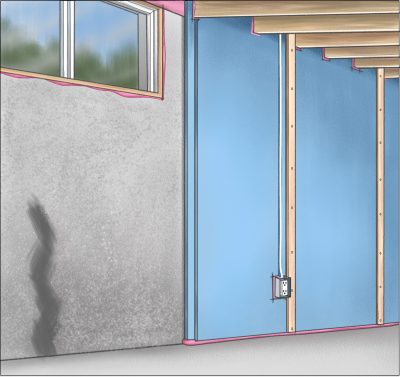Featured Video
Q: What steps should I take to insulate an unfinished basement in a house I’m thinking of buying? I don’t want to use spray foam and I don’t want the job to be too expensive.
A: The standard method of insulating a basement is to built stud wall frames against the foundation walls, stuff them with some kind of batt insulation, then cover everything with clear plastic. I strongly recommend against this, even if it is cheap and widely used. The slightest moisture vapour (not to mention liquid water) coming through the foundation wall will trigger mold growth and mustiness inside the wall frame. It’s like storing a wet towel in a plastic bag. This sort of thing happens all the time and this is why so many finished basement smell musty. Watch the video here for an explanation of why stud frames and fiber insulation is so risky in basements.
The most economical and safe way to insulate a basement is with sheets of rigid foam applied to the walls and held there with wood strips.  The strips anchor to the wall with screws driven into predrilled holes in the concrete, and the strips hold the foam secure. Even with this method, it’s very important that your basement be completely dry all the time. Never finish a basement that has the slightest water leak, but if some water should leak unexpectedly, it won’t be nearly as bad with impervious foam on your walls.
The strips anchor to the wall with screws driven into predrilled holes in the concrete, and the strips hold the foam secure. Even with this method, it’s very important that your basement be completely dry all the time. Never finish a basement that has the slightest water leak, but if some water should leak unexpectedly, it won’t be nearly as bad with impervious foam on your walls.
Does your basement have fiber insulation in plastic covers on the walls? This is common with newer homes and it’s what builders do when they want to meet minimum building code standards with minimal cost. Watch the video below for a strategy that makes good sense if you’ve got some of that common “builder’s blanket” insulation on your basement walls.



